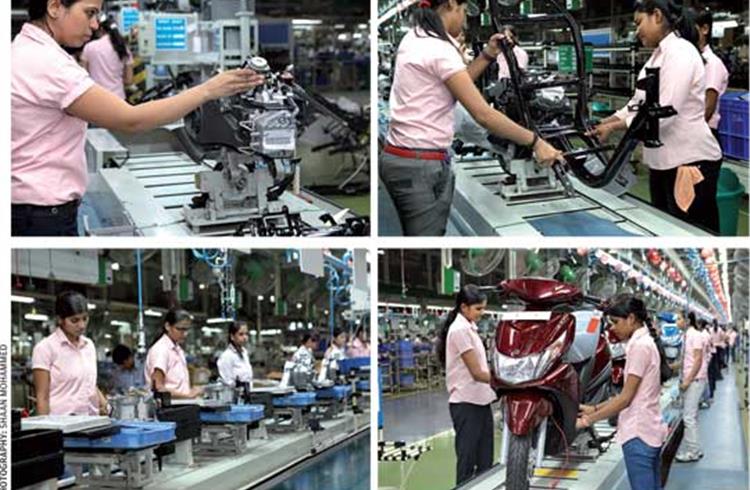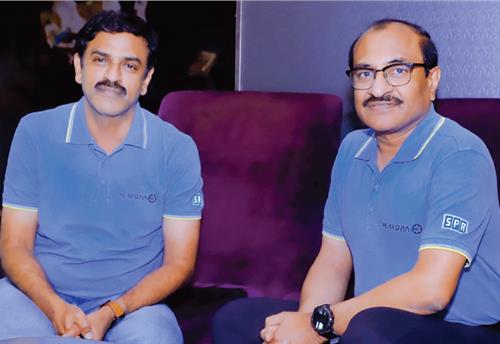2012 NCR Special: Yamaha prepares for bigger India role
India Yamaha Motor claims it is the first time in India that a company has developed scooters for women assembled by women.
CEO and managing director Hiroyuki Suzuki, it is believed, was keen to install an all-women assembly line for the Ray as he wanted to offer a very competitive product for women. Moreover, women are not usually in the forefront in Indian society, and this initiative was aimed at creating jobs for women, most of whom hail from small towns, says Suzuki.
At present, 250 girls work on the body and engine manufacturing operations of the Ray scooter with 92 of them working on the assembly line that rolls out 40 scooters at a stretch. The girls have been given industrial and hands-on training on assembly operations.
IYM claims it is the first time in India that a company has developed scooters for women assembled by women.
It has also developed a riding training programme for women customers known as the Yamaha Female Riding Training programme that will be implemented across India once deliveries of the scooters commence by end September. So far, the four-stroke 113cc Ray has received 5,000 bookings after which dealers have stopped in order to avoid long waiting periods. The Surajpur unit has a capacity of 15,000 scooters per month that will be ramped up, based on demand.
The facia design of the Ray and its flashlight curve is based on the eyes of an Indian actress, according to Roy Kurian, national business head, IYM. A designer from Yamaha Japan conducted a survey of young customers in India two years ago to assess the potential and came to the conclusion that the product had to be designed to have a strong suspension to handle bumpy rides and be fuel efficient. Further, in congested traffic conditions, the rider’s feet had to touch the ground.
The Ray has been designed exclusively for the Indian market and is not available in any other market so far. The product has been positioned in the 16-24-year age group.
The Ray will compete with the Honda Activa and TVS Pep, Hero Pleasure and the recently-launched 125cc Vespa. While HMSI leads with 599,049 scooters sold in April-August 2012, Hero MotoCorp is second with 187,846 units. The Activa brand itself sold 105,517 units in July 2012.
Big potential in India
Despite Indonesia being among the 10 fastest growing Asean countries, as per a study, Yamaha says the growth potential for two-wheelers in India is much more where one out of every 20 people possess a two-wheeler compared to one out of six in Indonesia. The dynamics of the Indian two-wheeler industry are undergoing a change. Though largely a motorcycle-driven market, scooters have been gaining ground over the last six years. Automatic gearless scooters have become increasingly popular, particularly with women, given the traffic conditions and the ease of riding.
The share of scooters in the total two-wheeler pie has increased from 12 to 18 percent over the last six years. With the two-wheeler market expected to rise to 20 million by 2016, IYM is targeting sales of over two million units and a 10 percent market share by then, with scooters contributing a sizeable chunk of this.
India’s scooter segment is growing at 25 to 30 percent annually. Last year, scooters accounted for 2.8 million of the two-wheelers sold and are expected to touch five million by 2015.
 |
The seriousness of Yamaha to grow equally strongly via the scooter trajectory can be gauged by the fact that it has adopted a top-down approach, and put its plans of introducing a new 100cc and 125cc bike on the backburner, for the time being, to make place for the scooter brigade, says Kurian. Scooters will provide a significant boost to the two-wheeler maker’s India operations as its upcoming plant at Chennai, that will go on stream in January 2014, will roll out scooters first from the assembly line, with the motorcycle portfolio to be added later.
Located close to the Chennai and Ennore ports, exports of scooters and motorcycles will also contribute a major portion towards IYM’s revenues as well as expand its export base. It will also be assembling engines at Chennai for export. The company is targeting exports of 300,000 units by 2014, up from the existing 190,000 units in CY 2011.
Once production at Chennai takes off, Yamaha expects sales volumes of one million by 2014 in which scooters and bikes will contribute equally, two million by 2016 and 2.8 million by 2018. The OEM is beefing up capacity at its Surajpur unit from 600,000 to a million by end 2012. The southern plant will have a production capacity of 1.8 million units.
IYM plans to focus equally on its bike and scooter product basket going forward. In 2011, it sold 330,000 motorcycles, with 400,000 sales of both bikes and scooters projected in 2012 in the domestic market with scooters contributing 40,000 to 50,000 units. Next year the target is to reach sales of 620,000 units.
IYM’s parts manufacturing unit at Faridabad produces engine and assembly parts. Engines are assembled at Surajpur. Export markets for bikes and engines are 15 countries like Columbia, Indonesia and Philippines among others, with the 150cc petrol engine also exported to Indonesia, and recently to Japan. Scooters will follow in due course as cost of manufacturing has proved to be lower for the OEM in India. Among the new markets are Africa and South America, especially Brazil. A likely contender for exports will be the 125cc executive bike.
IYM has achieved localisation of almost 95 percent in its engines and bikes with 500 suppliers located pan India and 200 suppliers in the south. The Chennai facility will also have a supplier’s park to meet JIT requirements.
The way ahead
The road ahead for Yamaha will not be easy. Though its India innings began in the 1980s, the company’s brand has got more publicity in recent years. The most popular product in its basket has been its 150cc bike that, says Kurian, has a 20 percentmarketshare in the deluxe segment.
India Yamaha Motor had a four percent market share in 2004 in the deluxe segment; that rose to 16 percent in 2011 with its FZ and SZ series, and is currently around 20 percent. Now the manufacturer has embarked on a consolidation strategy in the metros with future growth areas to be Tier 2 and 3 towns where it is expanding its dealer network to 430 by end-2012. Low-cost bikes are another potential area for growth ,especially in India and Africa, due to rising fuel prices and lack of two-wheeler penetration. India will be developed as a base for reverse innovation and low-cost bikes for exports to Africa. IYM has set up its own R&D division in India at its Surajpur facility, where work on new projects is underway. Scooters for the family segment are among the future products to be rolled out. By all accounts, it seems that after a considerably long and uneventful stint in India, IYM is ready for the great leap forward.
SHOBHA MATHUR
INTERVIEW WITH P P SHARMA, India Yamaha Motor's Group Head (HR & Industrial Relations)
 |
Yamaha has announced major expansion plans in the south of India. What implications does this have for the company’s hiring plans?
We will certainly accelerate our hiring plans and will be focusing on employing staff locally. The south plans call for the construction of a factory facility with a total floor space of approximately 114,000 square metres and is scheduled to begin in September 2012, with completion and start of operations scheduled for January 2014. According to plans, the new factory will employ 1,800 people and have an annual two-wheeler production rate of 400,000 units at the commencement of operations.
Given the talent crunch, how confident is the company of getting the numbers as well as quality of staff?
We are very confident in our hiring process. We hire young, energetic and talented people from premier institutes and this we consider as a stepping stone for achieving high performance. We recently hired a batch of 19 people as graduate engineer trainees and management trainees. We are confident in them and truly believe that they will deliver high levels of performance and quality and add value to the organisation.
What would Yamaha say is the USP of working with it when it hires young or fresh talent?
We believe in giving full liberty to our fresh talent so that their creativity is nurtured and they are able to perform their best in an open environment where they have enough space to experiment and innovate.
We are open to accepting their mistakes as we consider this to be a learning curve for them. We also give them training exposure by sending them to observe and learn operations at Yamaha Motor Co in Japan. Our remuneration is also extremely competitive.
What kind of estimated budget for training does Yamaha have? We have a significant budget set for training purposes. Other than that, we also have an in-house training division that imparts training on mind-mapping, people management and presentation and negotiation skills, to name a few.
Yamaha has been a relatively low player in the two-wheeler segment but that appears about to change. How has this been communicated internally to staff and vendors, to mention but a few stakeholders?
At Yamaha, we have a high degree of transparency. We consider not just employees but also the vendors to be an integral part of the organisation. For employees, we have various internal communication tools like monthly employee newsletters, notices, corporate mailers and the intranet that we use on a regular basis and keep the employees updated about the various developments in the organisation, be it sales volume, new product launches, management changes and new marketing initiatives. We also have an annual managers’ meet wherein the top management addresses the managerial staff and briefs them about the company’s plans.
For vendors, regular vendor meetings are conducted throughout the year wherein the management regularly updates them on the company’s plans, developments and new policies and initiatives.
Finally, can you give us an example of an HR initiative at Yamaha that you believe can be replicated across the industry?
We recently launched our new scooter, Ray, which is targeted at women customers. For this we had hired about 200 women workers to assemble the new Ray. So now we have an assembly line which makes scooters for women, made by women. This, we feel, is a very unique initiative introduced for the very first time in India.
We’re not just creating jobs for these girls but are also providing them with classroom as well as on-the-job training. By the end of their tenure here, these girls will be receiving an ITI certification approved by the state government. We certainly hope to see this initiative being replicated across the industry.
BRIAN DE SOUZA
RELATED ARTICLES
BRANDED CONTENT: Eliminating the worries of battery charging with smart solutions
The charging infrastructure is the backbone of electric mobility but is also one of the key perceived barriers to EV ado...
The battery-powered disruptor
Greenfuel Energy Solutions is planning to shake up the EV battery market with the launch of a portfolio of specially eng...
SPR Engenious drives diversification at Shriram Pistons & Rings
The engine component maker is now expanding its business with the manufacturing of motors and controllers through its wh...





 By Autocar Pro News Desk
By Autocar Pro News Desk
 03 Oct 2012
03 Oct 2012
 7246 Views
7246 Views









